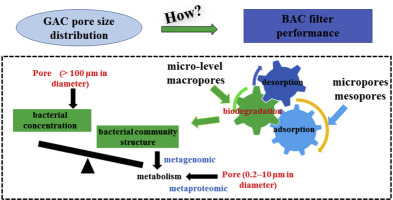当前位置:
X-MOL 学术
›
Water Res.
›
论文详情
Our official English website, www.x-mol.net, welcomes your feedback! (Note: you will need to create a separate account there.)
Effect of granular activated carbon pore-size distribution on biological activated carbon filter performance.
Water Research ( IF 12.8 ) Pub Date : 2020-04-03 , DOI: 10.1016/j.watres.2020.115768 Zedong Lu 1 , Wenjun Sun 1 , Chen Li 1 , Wenfeng Cao 1 , Zibo Jing 1 , Simiao Li 1 , Xiuwei Ao 1 , Chao Chen 1 , Shuming Liu 1
Water Research ( IF 12.8 ) Pub Date : 2020-04-03 , DOI: 10.1016/j.watres.2020.115768 Zedong Lu 1 , Wenjun Sun 1 , Chen Li 1 , Wenfeng Cao 1 , Zibo Jing 1 , Simiao Li 1 , Xiuwei Ao 1 , Chao Chen 1 , Shuming Liu 1
Affiliation

|
Proper granular activated carbon (GAC) selection could improve the performance of biological activated carbon (BAC) filters through a combination of adsorption and biodegradation, while the GACs used in BAC filters are now mainly selected according to adsorption function, ignoring biodegradation. In this study, sand filter effluent obtained from a drinking water treatment plant was fed into continuous-flow bench-scale BAC columns operated in parallel over 245 days to examine the effects of GAC pore-size distribution on BAC filter performance, in terms of the dissolved organic carbon (DOC) and disinfection byproduct (DBP) precursors. A metagenomic analysis indicated that bacterial community structure played an important role in BAC filter performance. A significant correlation was found between metabolism-related proteins and the volume of micro-level macropores based on metaproteomic analysis. It is suggested that the adsorption saturation was dynamic and that adsorption played a role in the performance of the BAC filters throughout the 245-day operating period. Renewed adsorption capacity, or bioregeneration, was driven by bacterial metabolic activity. Such activity largely depended on the organic matter adsorbed by the GAC, in which micro-level macropores, especially those with diameters of 0.2-10 μm, played an important but previously unrecognized role. The results suggest that more attention should be paid to well-developed pores and pore-size distribution in the production and selection of GAC used for full-scale drinking water biofilters.
中文翻译:

颗粒活性炭孔径分布对生物活性炭过滤性能的影响。
正确选择颗粒状活性炭(GAC)可以通过吸附和生物降解相结合来提高生物活性炭(BAC)过滤器的性能,而现在BAC过滤器中使用的GAC主要根据吸附功能来选择,而忽略了生物降解。在本研究中,将从饮用水处理厂获得的砂滤池废水进料到连续运行245天的连续流台式BAC色谱柱中,以考察GAC孔径分布对BAC滤池性能的影响,溶解的有机碳(DOC)和消毒副产物(DBP)前体。宏基因组分析表明,细菌群落结构在BAC过滤器性能中起着重要作用。基于元蛋白质组学分析,发现代谢相关蛋白与微级大孔的体积之间存在显着相关性。这表明吸附饱和是动态的,并且在整个245天的运行期间,吸附在BAC过滤器的性能中发挥了作用。细菌的代谢活性驱动着新的吸附能力或生物再生。此类活性很大程度上取决于被GAC吸附的有机物,其中微级大孔(尤其是直径为0.2-10μm的大孔)起着重要但以前未被认识的作用。结果表明,在用于全尺寸饮用水生物滤池的GAC的生产和选择中,应更加注意发达的孔和孔径分布。这表明吸附饱和是动态的,并且在整个245天的运行期间,吸附在BAC过滤器的性能中发挥了作用。细菌的代谢活性驱动着新的吸附能力或生物再生。此类活性很大程度上取决于被GAC吸附的有机物,其中微级大孔(尤其是直径为0.2-10μm的大孔)起着重要但以前未被认识的作用。结果表明,在用于全尺寸饮用水生物滤池的GAC的生产和选择中,应更加注意发达的孔和孔径分布。这表明吸附饱和是动态的,并且在整个245天的运行期间,吸附在BAC过滤器的性能中发挥了作用。细菌的代谢活性驱动着新的吸附能力或生物再生。此类活性很大程度上取决于被GAC吸附的有机物,其中微级大孔(尤其是直径为0.2-10μm的大孔)起着重要但以前未被认识的作用。结果表明,在用于全尺寸饮用水生物滤池的GAC的生产和选择中,应更加注意发达的孔和孔径分布。细菌的代谢活性驱动着新的吸附能力或生物再生。此类活性很大程度上取决于被GAC吸附的有机物,其中微级大孔(尤其是直径为0.2-10μm的大孔)起着重要但以前未被认识的作用。结果表明,在用于全尺寸饮用水生物滤池的GAC的生产和选择中,应更加注意发育良好的孔和孔径分布。细菌的代谢活性驱动着新的吸附能力或生物再生。此类活性很大程度上取决于被GAC吸附的有机物,其中微级大孔(尤其是直径为0.2-10μm的大孔)起着重要但以前未被认识的作用。结果表明,在用于全尺寸饮用水生物滤池的GAC的生产和选择中,应更加注意发达的孔和孔径分布。
更新日期:2020-04-03
中文翻译:

颗粒活性炭孔径分布对生物活性炭过滤性能的影响。
正确选择颗粒状活性炭(GAC)可以通过吸附和生物降解相结合来提高生物活性炭(BAC)过滤器的性能,而现在BAC过滤器中使用的GAC主要根据吸附功能来选择,而忽略了生物降解。在本研究中,将从饮用水处理厂获得的砂滤池废水进料到连续运行245天的连续流台式BAC色谱柱中,以考察GAC孔径分布对BAC滤池性能的影响,溶解的有机碳(DOC)和消毒副产物(DBP)前体。宏基因组分析表明,细菌群落结构在BAC过滤器性能中起着重要作用。基于元蛋白质组学分析,发现代谢相关蛋白与微级大孔的体积之间存在显着相关性。这表明吸附饱和是动态的,并且在整个245天的运行期间,吸附在BAC过滤器的性能中发挥了作用。细菌的代谢活性驱动着新的吸附能力或生物再生。此类活性很大程度上取决于被GAC吸附的有机物,其中微级大孔(尤其是直径为0.2-10μm的大孔)起着重要但以前未被认识的作用。结果表明,在用于全尺寸饮用水生物滤池的GAC的生产和选择中,应更加注意发达的孔和孔径分布。这表明吸附饱和是动态的,并且在整个245天的运行期间,吸附在BAC过滤器的性能中发挥了作用。细菌的代谢活性驱动着新的吸附能力或生物再生。此类活性很大程度上取决于被GAC吸附的有机物,其中微级大孔(尤其是直径为0.2-10μm的大孔)起着重要但以前未被认识的作用。结果表明,在用于全尺寸饮用水生物滤池的GAC的生产和选择中,应更加注意发达的孔和孔径分布。这表明吸附饱和是动态的,并且在整个245天的运行期间,吸附在BAC过滤器的性能中发挥了作用。细菌的代谢活性驱动着新的吸附能力或生物再生。此类活性很大程度上取决于被GAC吸附的有机物,其中微级大孔(尤其是直径为0.2-10μm的大孔)起着重要但以前未被认识的作用。结果表明,在用于全尺寸饮用水生物滤池的GAC的生产和选择中,应更加注意发达的孔和孔径分布。细菌的代谢活性驱动着新的吸附能力或生物再生。此类活性很大程度上取决于被GAC吸附的有机物,其中微级大孔(尤其是直径为0.2-10μm的大孔)起着重要但以前未被认识的作用。结果表明,在用于全尺寸饮用水生物滤池的GAC的生产和选择中,应更加注意发育良好的孔和孔径分布。细菌的代谢活性驱动着新的吸附能力或生物再生。此类活性很大程度上取决于被GAC吸附的有机物,其中微级大孔(尤其是直径为0.2-10μm的大孔)起着重要但以前未被认识的作用。结果表明,在用于全尺寸饮用水生物滤池的GAC的生产和选择中,应更加注意发达的孔和孔径分布。



























 京公网安备 11010802027423号
京公网安备 11010802027423号